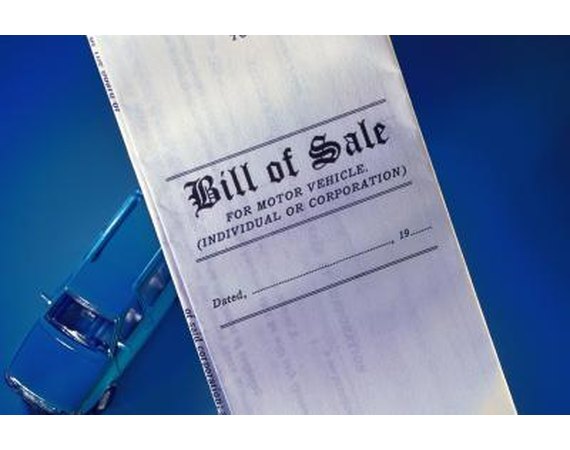When selling a car it's important that you provide the buyer with a receipt and also keep a copy for your personal records. The cash payment receipt -- also called a "bill of sale" -- for a used car also acts as a legal binding contract relieving you from any future responsibility involving damages, repairs, accidents or crimes associated with the vehicle. You don't have to be a car salesman or hire a legal professional to write a bill of sale. Follow a few basic steps to compose a legal sales receipt yourself.
1 Download a free automobile bill of sale form. The simplest way to begin writing a bill of sale for the car is to use a template form. Blank, printable bill of sale forms are available at the Auto Crisis website free of charge. You may also visit the Rocket Lawyer website to create a personalized bill of sale online for free and print it out.
2 Declare ownership in the fist section of the document. You must first introduce yourself as the owner of the car and include some personal information. Include your name and home or business address in a statement verifying that you are the legal owner of the vehicle. If you are not using a preprinted form, it should read something like this; "I Mary Jones, of 1234 Sunny Brook Ave., (city, state, zip code) hereby certify that I am the lawful owner of the under-mentioned vehicle and reserve the authority to sell it."
3 Include all pertinent statistics of the vehicle in the second section, such as the vehicle description, identifying aspects and registration information. You must include the make, model, year and VIN -- Vehicle Identification Number -- of the car. For example; Make -- Ford; Model -- Explorer; Year -- 2008. The VIN can be found near the dashboard on most vehicles and on the title of all cars.
4 Include information on the buyer and selling price. Unless you are using a preprinted template, carefully compose a section describing the transaction. Include the buyer's name and the payment accepted for the vehicle and the payment type. For instance, it may read something like this; "I hereby acknowledge the receipt of $____ (selling price) in the form of ______(cash, money order, check), from ___________(buyer's name), as full payment for the purchase of the said vehicle." Accurately fill in all of the blanks.
5 Compose a short summary of the transaction. In this section, add any disclaimers and conditions. If the car is not driveable or is severely damaged, mention specific flaws in this section. No matter what condition the vehicle is in, you should clearly include the phrase "Sold As Is" to avoid any future expectations of repairs or reimbursement by the seller. Include the exact mileage of the car at the time of sale.
6 Relinquish all responsibility for the car to the buyer. Compose a short statement proclaiming that you have waived all ownership rights and responsibilities upon receiving payment and making delivery of the car as of the date of receipt. Clearly state that by signing the document, the buyer accepts all full responsibility for the car and all associated liabilities, damages and third-party damages involving the vehicle from the date of the sale.
7 Complete the payment receipt with appropriate dates and signatures. At the conclusion of your document, add a line titled "Seller" and another titled "Buyer," each followed with an appropriate amount of blank space to accommodate the correspondent signatures. Beside each signature line, include the word "Date" with a blank line for each party to enter the correct date of sale. The buyer and seller must sign the appropriate areas to complete the sale of the vehicle.


























